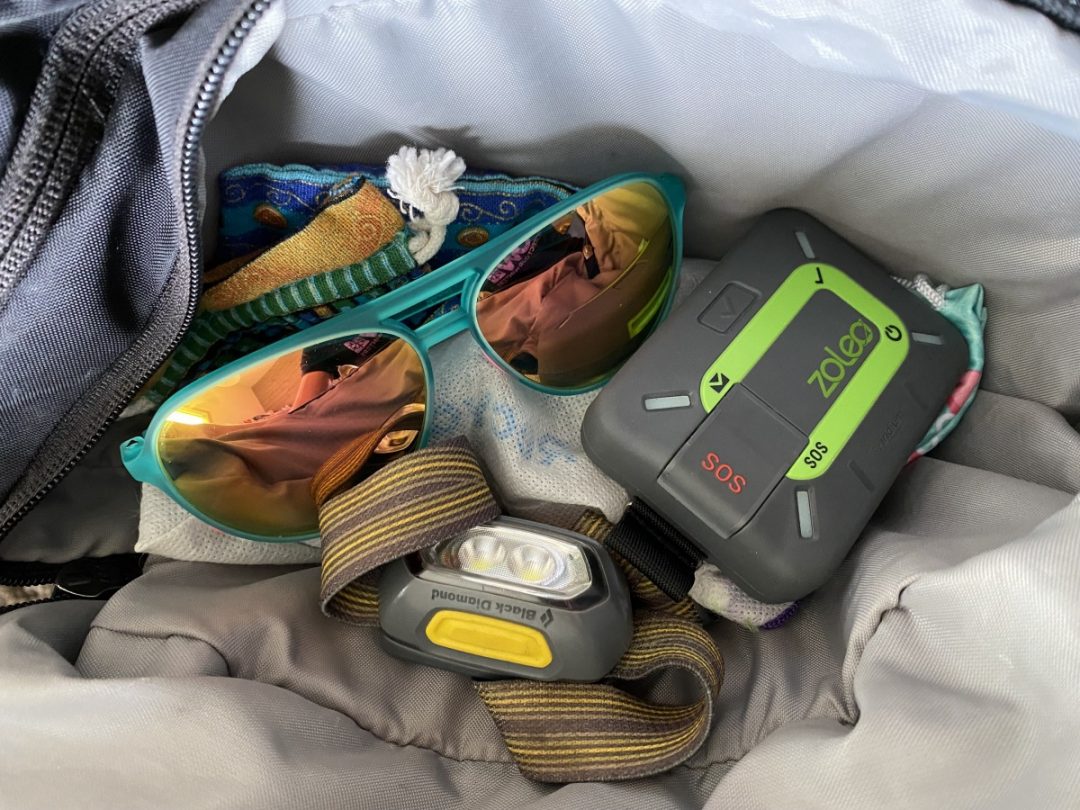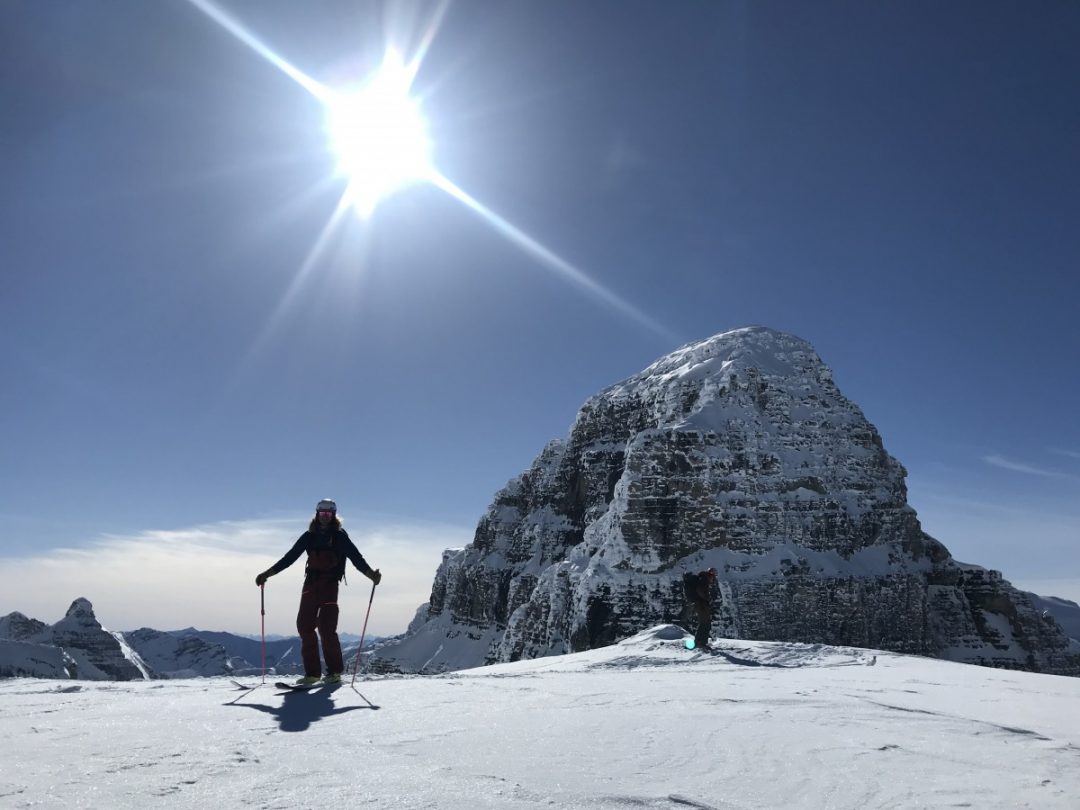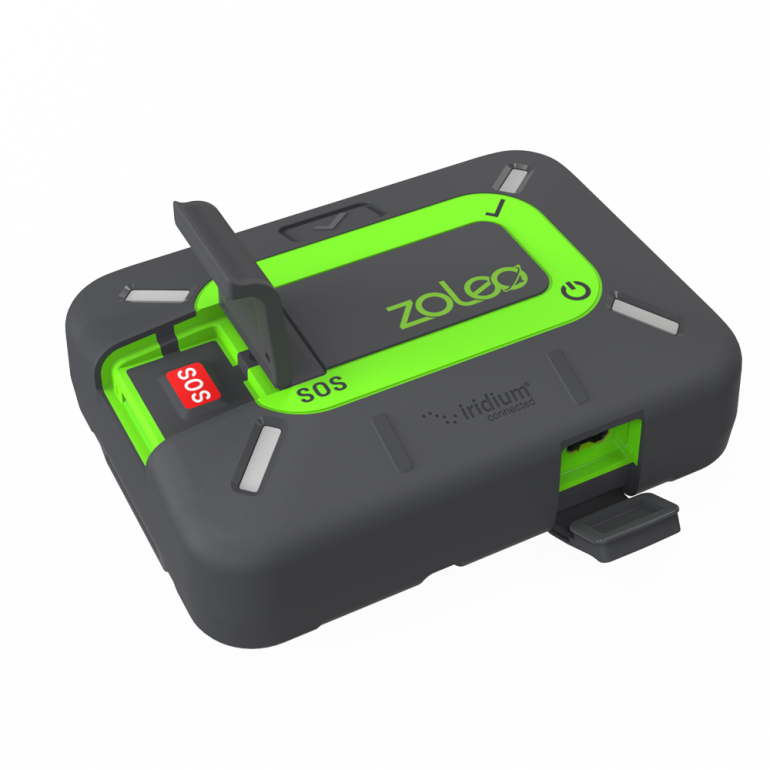
The Zoleo satellite communication device is about the size of a deck of cards, and provides a means to communicate when off the grid. This is WildSnow’s deep look review after using the device for several months.
“Hello from SHARK” I type into my phone’s the Zoleo app. I press send, and with a blink of lights and satisfying chime, my message goes out into space and I wait for a response. I am managing the remote helicopter pad for Talus Backcountry Lodge on an exchange day. The weather is not cooperating. Visibility is poor, winds are gusting moderate to strong and it’s snowing heavily.
The SHARK Helipad is used as a staging area to shorten the helicopter flight into the lodge, making the multiple flights required for a guest exchange more efficient. The remote location is off the grid in terms of cell phone coverage. We usually use high-powered GRMS radios to communicate with the helicopter service and lodge, but even using a repeater, the radio coverage is spotty at best, especially when the helicopters aren’t flying and cant relay messages. Enter the Zoleo Satellite Communicator device.
The lodge has a satellite uplink running a private wifi network primarily for weather updates and other critical info. On exchange days, when we have one group of guests exiting while another arrives, the Satellite Wifi serves as a valuable communication resource. It allows lodge staff to check email and phone messages.
I receive a text back from Talus, “flights delayed 1 hr”. I pass this info on to the waiting guests. An hour passes, then I get another message. “Flights canceled for today, please do the avalanche briefing and take guests for a tour from your location.”
Throughout the day, the Zoleo serves as our primary means of digital communication. Due to our weather-caused change of plans, the Zoleo affords us a link to update guest schedules and coordinate an impromptu ski tour.

Finding higher ground to connect to space with the Zoleo in BC’s backcountry.
Luckily I have never had to use the Zoleo in an emergency scenario, but all this logistical wrangling has me convinced of its function and reliability should the need arise.
While connected to the Zoleo, the battery on my phone drained faster than usual when my phone sits in airplane mode for a day. I was alerted my phone had 20% battery power remaining amid the day’s communications described above. I would likely carry a spare rechargeable battery pack in the future to ensure I didn’t run into a situation where I couldn’t customize texts due to a dead phone battery. As described in my Zoleo First Look, The Zoleo can only send a generic “I’m ok” message to 5 pre-determined contacts with location info, or a SOS Message to the same 5 contacts and emergency services while not paired to a phone.
Something noted in the first look, the Zoleo requires the phone app to engage in custom two-way texting, which comes in handy in emergency situations. Absent a functioning phone, and in an emergency, the Zoleo does not have the means for stand-alone custom text.
Some basics from the first Look:
Dimensions: 65mmx90mm (12mm thick).
Weight: 150g
Network: Iridium satellite network
Cost for unit: $199.00
Cost for required plan: Basic ($20/mo), In Touch ($35/mo), Unlimited ($50/mo).
Satellite connectivity in the locations around the lodge in the rocky mountains of eastern British Columbia was good. Still, there were times when I was in deep valleys with steep walls when the device could not connect to satellites. Knowing the coverage limitations is useful and was easily learned by checking the device connectivity in varying terrain and aspects. Not an ideal solution, as the messenger doesn’t work everywhere, but it functions as well as anything else could, and gaining high ground always seemed to allow for connectivity to the satellite network.
The Zoleo was my first experience with a satellite messaging device, and the ease of use and functionality has convinced me that these devices are extremely useful in the field. After our successful no-fly day communications, the owners of the lodge purchased three satellite communicators (they went with the Garmin inReach as it is considered the industry standards) based on the ease and convenience of communication we achieved during that day. The old backup communication was a Sat Phone, which is bulky to carry and expensive to use. Satellite messenger units with much more affordable data plans and reliable messaging are now the new standard for remote communications at many backcountry sites.
The Zoleo functioned well in the field and was easy to use. The unit’s battery was robust even after a full day of use. I was able to get a week’s worth of use out of the Zoleo before it needed a recharge, but that time will likely vary depending on total messaging usage, temperature and other features. I do have reservations about phone tethering as the only way to customize texts, something not required on other similar units like the Garmin inRreach. I also feel like the Zoleo data plans are a bit on the spendy side compared to other options (see the first look). As a satellite communication device, the Zoleo worked very well, was intuitive to use, and I suspect it will make its way into a permanent location in my backpack.

The Zoleo satellite communicator provides a link to the outside world when off the grid. Here, the unit’s SOS button and USB port are revealed. (Photo: Zoleo)
Through some trial and error, I discovered the importance of tailoring your messages in a compatible platform with those you communicate with. For example, the lodge’s Wifi allows for iMessages and iMail but does not deliver SMS messages, which is the primary format of messages sent from the Zoleo. Sending messages to an email address was the answer to sending messages reliably using the lodge’s WiFi network. Take note; most email programs do not alert the end-user to message arrivals the way a text message on a phone does, so thoughtful checking of email on the receiving end becomes necessary.
Another anecdote is that practice with the device pairing to your phone and sending messages should be done before use in the field. On our ski back to civilization after shutting the lodge down for the season, we attempted to send a message back to those remaining staff at the lodge. We communicated our avalanche obs for the day and were unsuccessful using a Garmin inReach due to user error.
Luckily I had my Zoleo and was practiced; I relayed the info. Attempting to learn to pair and troubleshoot electronic devices in the cold and wind and snow is less than ideal. Like any tool, practicing and familiarizing yourself with how things work before an actual need arises is a good idea.
Bottom line: The Zoleo was a reliable, highly useful tool for backcountry communication. As with any piece of technology, using it requires some practice and familiarity. Do your research on devices and plans, pick the device best suited to your needs, practice using the device, and find yourself safer and more at ease in off-the-grid locations. I anticipate these devices will soon become standard safety and convenience items for backcountry travelers if they aren’t already.
Barry Wicks, also known as @wicknasty, demphasizes the nasty and embraces the kindness. He lives in Bend, Oregon where in a parallel universe he covets all things cycling. And although he might not admit it, some say he was once quite speedy on a bike. Also, amongst WildSnow writers, he has the best hair.
